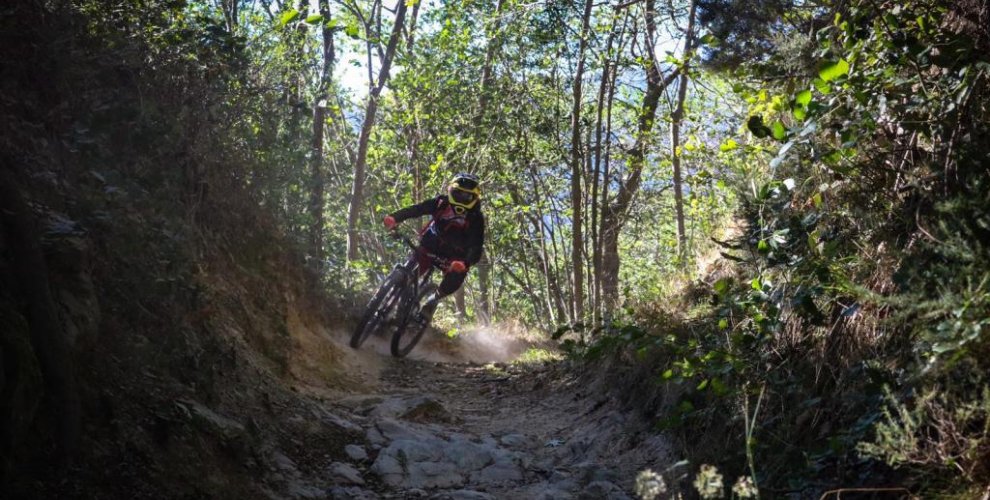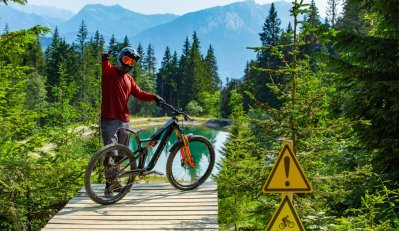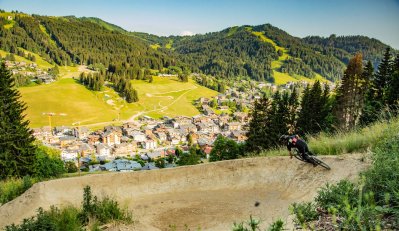The popularity of the Enduro World Series has given rise to a new breed of mountain biker. This rider takes multiple guises beyond the die hard racer that we would have seen in years gone by dedicated to traditional downhill or cross country disciplines. They are out for an adventure, a travel experience.
The possible reasoning behind this is the accessibility of the EWS and their feeder series around the world. Without saying an enduro race is easy, far from it! But you can enter a race with the goal of just going to experience the event, how you fare against the clock is merely part of the program rather than the primary goal.
The travel and new trails a rider is exposed to mean the idea of racing is adaptive. You can train, focus and race to do the best you possibly can, or you can see an event come up, put your name down to enter and once you have the relevant race license and insurance, you can let the adventure begin!
However, does the inner competitor in us all take over once you hear the beeps?
Enduro World Series Challenger - Clients Perspective
The EWS is a race series of course, but it like any organisation it is a business. In 2018 it opened it's doors further to the general riding public with the Challenger and now EWS 80 and EWS 100 events. These were designed to be a mini race within a race. Participants would contend a shorter version of the full event over one day, the goal being to allow entrants racing for the first time, or wanting to have a crack without the full commitment and pressure of the full race program.
In Autumn 2018 five of our clients decided to give it a go in Finale Ligure as part of their holiday with us on a Riders Week.
After some frantic last minute emails, race licenses and medical certificates were arranged, they were in. Always check what you'll need to legally race before entering any event, anywhere, was the moral of the story, but once fees had been paid conversation moved to practice on Friday, with the race being held Saturday.
Nick, Matt, Ronan, Brad, Barry and Michael were racing in Finale Ligure.
You can race and holiday at the same time in Finale Ligure
With the clients onboard, Finale guide Sandra and I decided to jump in myself, in part because I knew the course for Sunday's main event and didn't feel like putting myself through it! We hopped aboard the MTB Beds Transporter to the start of Stage 1.
Pino Bago was a stage made up of two trails in Feglino, Pino Morto and Ori Bago. short and lots of fun, with plenty of classic Finale Ligure rock and flow, with a horrible pinch climb, which felt like 5 minutes, the transfer between the trails.
We spent some time picking and practicing lines through the tricky rock garden at the entry of Pino Morto. Inside and rough, centre and straight forward or outside but with consequence. It's great to see the reaction of people who have wouldn't often stop and consider how to hit this kind of section in a race, it's always revealing and I hope they found it helpful here and throughout the day.
Spirits were high as we drove up through San Bernadino, behind Finale Ligure and made the short pedal transfer to stage two. A new take on an old classic, La Ruggetta. A personal favourite, it's quite flat with a super fun rock and loam section at the top, with some technical pinch sections littered with pedal catchers. We spotted afew sneaky inside lines, opening the trail up more, and a cool hop on hop off rock that would no doubt save us some time on the competition!
Stage 3 was a lesser used trail, wide, open and fast with one quite technical corner littered with loose rock. Called Briga Destra, we spent some time considering the benefits of high outside with a fast exit or tight inside with a shorter A to B but a slower exit.
La Ruggetta - Stage Two EWS Challenger 2018
At this point we'd been together the entire day. It felt like any other shuttle day in Finale Ligure, with some added question time and technique sessions. Everyone felt comfortable, and despite reservations about the amount of climbing involved once the van had left us, the crew felt confident.
That changed dramatically once we headed to the final stage, the infamous Men's DH. It's used in just about every marketing campaign Finale Ligure have and certainly as the focal point of every EWS held here. Crowds line the final section as racers tackle the gnar to the ocean in picturesque Varigotti below.
We'd been practicing up until this point with each other and had seen no pro's. The first three stages not being on the full EWS program. Excited, the guys chatted with the likes of Joe Barnes and Florian Nicolai on the way up to the start point.
Unknown to most spectators the trail starts a long way before the famous rock garden. A long, flat pedal section a couple of short but painful climbs ensue before you reach the 'fun' part. Lulled into a false sense of security, the guys made their way down, wondering what all the fuss was about, no doubt getting a little apprehensive in the back of their minds.
When you see the likes of Fabien Barel (who can still absolutely shred) and Remi Gauvin take on a technical trail like this, it's enough to make you wonder how it's possible to ride such a thing and make it look easy. It's a hard enough trail as it is with the rock drops and loose kitty litter making it near enough impossible to control your speed once you've let off the anchors for afew seconds, but with the eyes of some of the top pros in the game on you, it's enough to put any amateur on edge.
Afew white faces were definitely appearing amongst the team. With Sandra having to leave due to a puncture at the top, it was down to me to try and calm the nerves and keep morale high as we talked over the best methods of tackling this steep rock garden grandstand finish. Survival being the optimum phrase.
It was here we lost our first competitor before the event even began. Ronan, the most gun ho of the group had the skills and confidence to take this on but took a big fall in one of the sketchiest sections, damaging his ankle. He needed assistance to get down the hill, gutted, knowing he would be unable to race the next day.
That night rumours circulated around the dinner table of not racing. The comfort of the shuttle van was alluring. Other clients who has spent the day with the shuttle van elsewhere in Finale, watching the top pro's tackle the rocky steeps of Rocche Gianche told stories of helicopters ferrying injured racers to hospital. Was it all going to be too much?
Dialling in the lines on stage 3, Briga

Early the next day, everyone except the injured Ronan lined up to collect timing chips in the Finale Ligure piazza. Still apprehensive about the day ahead. After a quick interview on the podium set off on the long climb to stage one.
The reality of having to make your way to trails under your own steam set in pretty fast, all the boys struggling over the first climb. Taking 30 minutes to an hour dependent on your fitness level, the drinks stop at the top was warmly welcomed. It's fair to say though each one made the climb, it wasn't comfortable.
The first stage went well for the most part. One mechanical and everyone making a mistake on the climb. A quick gear change was needed to anticipate the up and many a pedal was slipped! This cost all the lads a fair amount of time, Nick taking a tumble down a wall!
On the climb to the second stage they started to lag. Legs and lungs that are used to light pedalling at the weekend all of a sudden had to get man and machine up solid ascents of 45 minutes plus, with energy to race.
This is where the unknown or un-quantifiable of racing comes in. The adrenaline of hearing a beep or seeing a clock, having a racer behind you, looking at your liaison times glued to your top tube like a school timetable. Even for a relatively unimportant event like this, it plays with the mind and equally saps and gives energy to spur you on or hold you back.
Once I had completed stage 2, I waited and waited for the guys to show up. After 20 minutes i got word that they had taken a breather at the start, that they would catch up in Finale centre, before starting the push to stage 3.
They didn't arrive. Matt, Brad and Nick retired after the second stage due to crashes. This left only Barry and Michael left in the race. We lost track of these last two the afternoon drew in. Fitness levels meant longer recovery times and longer liaisons, in the hope of staving off cramp and fatigue myself I left them to it.
Barry and Michael both finished the day. Even though they'd finished a fair way from the pointy end of the field, they were grinning ear to ear with a beer in hand in Finale's piazza, in amongst the EWS pits, telling stories of making the last stage with only 5 minutes to spare, after over 6 hours in the saddle. They were stoked!
For my part, I can tell you about the experience is the surprising levels of fitness that are required just to have fun on this kind of event. The Challenger is all about a more relaxed atmosphere, but we all push a little harder when the clock is ticking.
I made it around the course without issue, i'd consider myself relatively fit, but struggled massively putting in any serious cardio effort mid stage. I didn't know when my body was ready to push, as i'd think I had the energy to burn on short climbs or sprints, only to find my legs tired and lacking power.
Happy to finish my day in 5th, without injury and only narrowly missing out on my goal to win the final stage, men's DH, but with a bit more knowledge and some training I could not only have enjoyed the day more but could have pushed quite a bit harder. I'm sure the boys would agree!
Fergus Ryan in action at an EWS
Fergus Ryan has been racing bikes since he could read the words on an entry form. He's the resident MTB Beds pinner, having joined as marketing manager in 2017. He's been having a crack at the Enduro World Series for the last two seasons.
What's the most challenging aspect of racing a single enduro world series event?
Can you give an insight as to what this is that the first timer may not realise?
When it comes to racing an EWS event there are so many differing aspects compared with your UK or local enduro race. The most challenging of these would definitely be recovery, this sounds like a simple thing but it is crucial in terms travel, practice and race day. Due to the nature of the world series, there is a high chance that these events won't be close to home, this mean either flying or driving to the events both of which can have a detrimental effect on your performance if not properly managed.
It is key to always have an organised plan of when you are arriving to the race and allowing enough time to adjust to the climate and travelling you have done.
When it comes to practice this is also important, with the EWS becoming more and more physically demanding you need to conserve energy on the practice days, this means starting and finishing the day as early as possible to give you time to recover.
When I took part in my first race, I was unprepared and practiced at 85% of my maximum as my fitness levels were not at the same level as others this was a mistake leaving little in the tank for the race days and meant I didn't take the tracks in properly.
What do you look forward to the most when travelling to a race?
My favourite part to every race is seeing the new tracks and riding different and exciting terrains. This is one of the unique things the EWS offers over all other enduro events, the tracks are always new and challenging meaning the playing field is as level as possible going into the race weekend.
What has been the best event you've raced and why?
My favourite event of the year has to be Finale Ligure, having raced their the past two rounds and being fairly new to the area I love the way you can ride so many different terrains in a days pedalling. Another awesome part to the Finale race are the fans, there is no better feeling that charging down the final part of the men’s DH with nothing but crowds the whole way down the track, its is something that you just don't get at the other events.
Do you ever get to experience more of the town or riding area at a race or is it always kept between the tape?
This depends a lot on the event design and when you arrive in the area. For me I like to explore the towns I travel to as without the racing it is unlikely I would have visited many of these stunning areas. My favourite two towns have to be Finale Ligure and Madeira, both have a stunning seafront but also a very old school vibe.
How much time do you dedicate in the year the specific training programs, beyond just riding for fun?
I train twice a week in the gym for around an hour and half followed by a ride 6 days a week. These are not always all out rides but it is crucial to build up your base miles over the off season on top of strength and stability training. I also commute 15 miles each way to work which helps to build up my base miles and also have regular stretching sessions in the evenings.
On the weekends I get out on my race bike. I try to mix up where I ride and who I ride with, this is another key part to my training, riding with different people can help you to learn new skills and new approaches to trails as well as mixing up the paces of riding.
When I competed in downhill, one of the key components to my racing was a pre season camp or race, this involved a full week trying to replicate what I was going to do in the season and to “blow off the cobwebs” in terms of racing. It was a great opportunity to level the playing field of the professional riders I was competing against as they all go on camps prior to racing. It was also another opportunity to really get to know my race bike and tune it in an environment similar to that I was going to be racing on, as much as UK riding is awesome it is not comparable to the length and roughness of the trails you experience on the EWS.
Fergus Ryan practice full run of Men's DH 2018
Book a trip to Finale Ligure
To book onto a Finale Ligure Riders Week to ride this terrain for yourself, see below;
Featured Properties
Photo credit Tom Hardman & Enduro World Series








